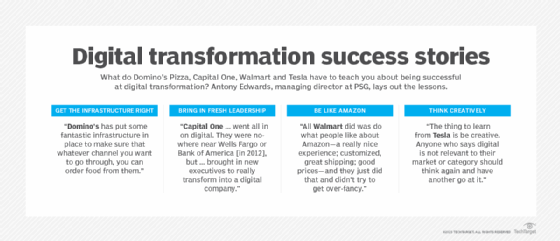7 examples of digital transformation success in business
Seeking out role models for your digital transformation initiative? We outline the steps taken by masters of digital transformation and explain what you can learn from them.
Businesses are implementing digital transformation initiatives to gain faster time to market, stay competitive and optimize the customer experience.
Despite challenging economic conditions, 60% of enterprises told Boston Consulting Group X they were increasing their digital transformation investments in 2023. By 2025, the digital transformation market is expected to reach $1.458 trillion, according to a recent report from Precedence Research.
Antony Edwards, managing director at growth equity firm PSG, classified digital transformation efforts into three types:
- Organizations making their products or services more digital.
- Organizations adopting digital technologies to change how they engage with their customers regardless of whether their products are digital or on premises.
- Organizations transforming internal infrastructure to change how they work.
 Parry Malm
Parry Malm
But unlocking digital transformation success is not everyone's forte. It is especially hard for businesses that have yet to embark on their transformation journey, according to Parry Malm, CEO and co-founder of Phrasee, an AI company that makes natural language generation software.
Among companies pursuing digital transformation, Malm expects large players will continue making gains because they've got the resources to course correct. The ability of small companies and startups to change and to outmaneuver big companies keeps them competitive. Midmarket companies are in danger of being squeezed out at either end, according to Malm, making it imperative they understand the systems and processes that lead to successful business transformations.
This article is part of
What is digital transformation? Everything you need to know
What are the benefits of a digital transformation?
To get the business benefits of digital transformation, companies should always focus on outcomes.
 Sanjay Srivastava
Sanjay Srivastava
Sanjay Srivastava, chief digital strategist at Genpact, said he sees enterprises across industries achieve an ROI from their digital transformation efforts when they deal with specific business imperatives -- rethinking customer experience, increasing operational productivity and optimizing their supply chains. While technology is only part of the digital transformation equation, the most successful efforts he sees take advantage of innovations in digital technologies, data and AI.
 Kristin Moyer
Kristin Moyer
Kristin Moyer, an analyst in Gartner's CEO and digital business leader practice, said that digital transformation done well optimizes and transforms a company's business.
"With optimization, the outcomes that you're getting are things like improved efficiency and improved engagement with customers," she said. "With transformation, what you're focusing on is brand new revenue -- for example, new digital products and services and new business models."
 Jason Frugé
Jason Frugé
Executing on a digital transformation roadmap helps businesses stay relevant and expand their customer base by meeting "consumers where they are," said Jason Frugé, consulting CISO at Risksilience, a cyber security consultancy.
"People are more and more reliant on digital technology. … They want to do business with you on their cell phones and iPads. And unless you transform your business and accept that new reality, you will get left behind," Frugé said.
Digital transformation should also lead to more agile IT and engineering teams that enables them to execute projects in a much faster fashion, these experts highlighted.
Notable examples of companies that achieved digital transformation success
Achieving success in digital transformation requires a clear vision and understanding across the organization, experts agreed. Utilizing digital technologies is just one piece of the puzzle. Having the right leaders in place, investing in talent and skills development, instigating cultural and behavioral changes, ensuring frequent and clear communication, and digitizing tools and processes are important when driving transformational success.
Here's a look at seven notable examples of digital transformation success stories and what companies can learn from them.
1. Domino's Pizza
Domino's successful implementation of technology-driven transformation helped the pizza giant evolve into "an e-commerce company that sells pizza," according to Dennis Maloney, the company's former chief digital officer who led the effort.
After the company's stock price plummeted in 2008, Domino's implemented an initiative aimed at revamping its menu and at using digital technology to increase agility. As part of its effort to deliver better products and services to customers, the company launched Domino's Tracker, a next-generation delivery technology that let customers follow the progress of their order online. Today, Domino's AnyWare technology lets customers order in more ways on more devices.
The company has touted its use of artificial intelligence and machine learning technology to improve product quality as well as boost store and online operations. The company's multi-year experimentation with autonomous vehicles and drones for pizza delivery has kept Domino's in the vanguard of companies that push the boundaries of digital delivery.
Experts who have studied the company's success in infusing digital innovation into its business agreed that its new profile as the "pizza experience company" depended heavily on strong executive support. Creating an extensive and empowered IT department that collaborates with marketing counterparts to attract new and existing customers was also critical to the company's digital transformation.
"Domino's is an example of getting the infrastructure right," Edwards said. "They have put some fantastic infrastructure in place to make sure that whatever channel you want to go through, you can order food from them. That makes for a seamless experience across different devices."
2. Capital One
In 2012, Virginia-based credit card banking company Capital One embarked on a transformation journey to build "a technology company that does banking instead of a bank that just uses technology," CEO Richard Fairbank said. The stated goal was to deliver personalized banking service in real time.
Building on a modern technology stack, the company used big data and machine learning to better understand customers. It brought in the talent required to build personalized apps, adopted cloud computing and implemented agile software development and DevOps practices, including the use of open source software.
In November 2020, it announced the closure of all on-premises data centers -- becoming the first U.S. bank to do so -- and moved all applications and systems to Amazon Web Services. This cloud-first policy helped Capital One and its digital transformation team move away from infrastructure management and focus on accelerating customer-centric innovation by using machine learning to turn data into insights.
"Capital One is someone who just went all in on digital," Edwards said. "They were nowhere near Wells Fargo or Bank of America [in 2012], but their digital transformation means they're getting all the new young subscribers to banking. They even brought in new executives to really transform into a digital company."
3. Walmart
Walmart has been on a journey to transform itself into a technology and innovation company, with the goals of making shopping faster and easier for its customers as well as offering new digital experiences.
Walmart changed its focus from "re-platforming its e-commerce business" to "re-platforming across the board" and put the digital transformation budget in place to do it, spending $16.1 billion on technology in 2022, according to independent industry research.
It also forged several strategic partnerships to accelerate its transformation initiatives. It partnered with Microsoft to capitalize on the cloud giant's compute capacity to scale its artificial intelligence, machine learning and data analytics initiatives as well as with Google for voice-enabled shopping.
The company consistently invested in digitalizing every aspect of its business -- from supply chain to sales, customer service, marketing and store operations -- to boost its operational and cost efficiency. Walmart's supply chain digitalization is integral to its omnichannel strategy success, which helps the company serve customers through online, mobile and in-store interactions.
What businesses can learn from Walmart's "astounding digital transformation," Edwards said, is that they need to get the basics right.
"There's no magic in digital transformation," he said. "All Walmart did was do what people like about Amazon -- a really nice experience; customized, great shipping; good prices -- and they just did that and didn't try to get over-fancy."
4. Tesla
Electric car-maker Tesla is inarguably one of the most prominent examples of digital transformation success. By infusing technology into all facets of the driving experience, the company has positioned itself as a change agent within the automotive industry.
From Tesla cars receiving over-the-air software updates to the company setting a high standard for customer experience, Tesla has disrupted the traditional auto world in many ways.
Tesla's success can be attributed to three broad technology-driven choices: eliminating the middleman in the car-buying process, extensively using digital technology to redefine how cars are built and driven, and embracing its approach to innovation.
- Tesla's direct-to-consumer model, where it sells directly to consumers through its website and not through franchised dealerships, lets Tesla control the buying experience.
- Tesla's in-house production strategy -- a deviation from the industry norm of sourcing components from third-party suppliers -- not only provides cost advantages but also helps the company innovate quickly.
- The velocity at which Tesla innovates -- the launch of Tesla Gigafactories to support Tesla's projected vehicle demand, for example – gives the company a major advantage over legacy automakers.
Today, Tesla's market capitalization is around $830 billion. It holds an 18% market share of global electric vehicle sales.
"The thing to learn from Tesla is, be creative," Edwards said. "Anyone who says digital is not relevant to their market or category should think again and have another go at it."

5. Automotive manufacturers adopt AR to expedite dealership repair service
Legacy car companies have been taking notes from Tesla to achieve similar gains. An example is the recent partnership between Indian IT services firm Tech Mahindra and a leading automaker to digitally reimagine the process of building and selling cars with the help of cutting-edge tools.
Working with Tech Mahindra, the automaker has invested in augmented reality technology to improve collaboration between the automaker's technical experts and the after-sale service at their dealerships.
 Krishna Bala
Krishna Bala
In the past, when cars came in with complex problems or issues that required rare performance part specifications that dealership mechanics couldn't resolve on their own, manufacturing experts would have to visit the dealership or ship the problematic cars back to the plant for inspection, said Krishna Bala, a senior vice president in sales at Americas for Tech Mahindra. The AR software helps service technicians relay information to the plant experts efficiently, resulting in faster and more accurate resolutions for complex vehicle service issues.
AR technology also improved end-customer and dealership employee satisfaction. "The strong ties between their operational and technological wings allow them to be ahead of the curve in implementing digital solutions with minimal disruption to business," Bala said.
6. Financial institutions boost earnings, customer satisfaction with fin-tech
 Jason Brucker
Jason Brucker
Jason Brucker, a managing director in the technology consulting practice at Protiviti, recently worked with a leading financial institution that transformed its traditional operating model to a financial technology, or fin-tech, operating model pioneered by financial upstarts. The organization also underwent a substantial rebranding exercise in parallel to the operating model and digital transformation.
The CTO office initially kicked off the process, focusing on driving these changes across the organization. However, the CTO office quickly realized it first needed to establish greater alignment with business partners as well as optimize its own technology operating and governance models.
The company also established a business transformation office that reported to the CTO. This team focused on aligning portfolio management with risk management and process reengineering. This group also implemented a new goals framework with clear objectives aligned across the company and tied portfolio investment decisions to these goals. Equally important was a focus on transforming the enterprise governance structures as well as existing functional teams and processes.
Measurable benefits included improved efficiency, growth in earnings per share, faster partner engagement and integration, improved employee engagement, and reduced turnover. Although the overall transformation efforts were daunting in scope, the organization saw results just a few months into their efforts. Brucker attributes this to success to enabling organizational change across the enterprise, not just within technology teams or in small sections of the business.
7. Healthcare industry uses DX tech to compress drug development cycle
Srivastava points to the impact COVID-19 had on digital transformation across the healthcare industry. Faced with a global epidemic, the industry compressed the typical eight-year drug development cycle to eight months to produce the COVID-19 vaccine.
This required digital transformation across processes used in drug discovery and clinical trials to dramatically accelerate speed to market. The most successful transformations also took advantage of recent innovations in data infrastructure and knowledge graphs to identify transformation opportunities and improve collaboration, Srivastava said.
Now he is seeing many of these firms pivot from batch manufacturing and retailing mass medicines to precision medicine -- the ability to produce and deliver personalized medicine specific to a patient's DNA built on a new backplane of data, IoT technology and analytics.
One takeaway from the most successful transformation projects in healthcare is that digital transformation is entirely different from digitalization, Srivastava said. Digitalization is about automating end-to-end processes, while digital transformation reimagines the total business process.
Srivastava said that digital transformation projects that deliver the greatest returns pay a lot of attention to "how to integrate the digital solution back into the enterprise workflow, redesign the experience around its consumption, drive adoption, reskill the team, and change operating models to take advantage of it."
Editor's note: Mekhala Roy originally wrote this article, and George Lawton updated and expanded it.






